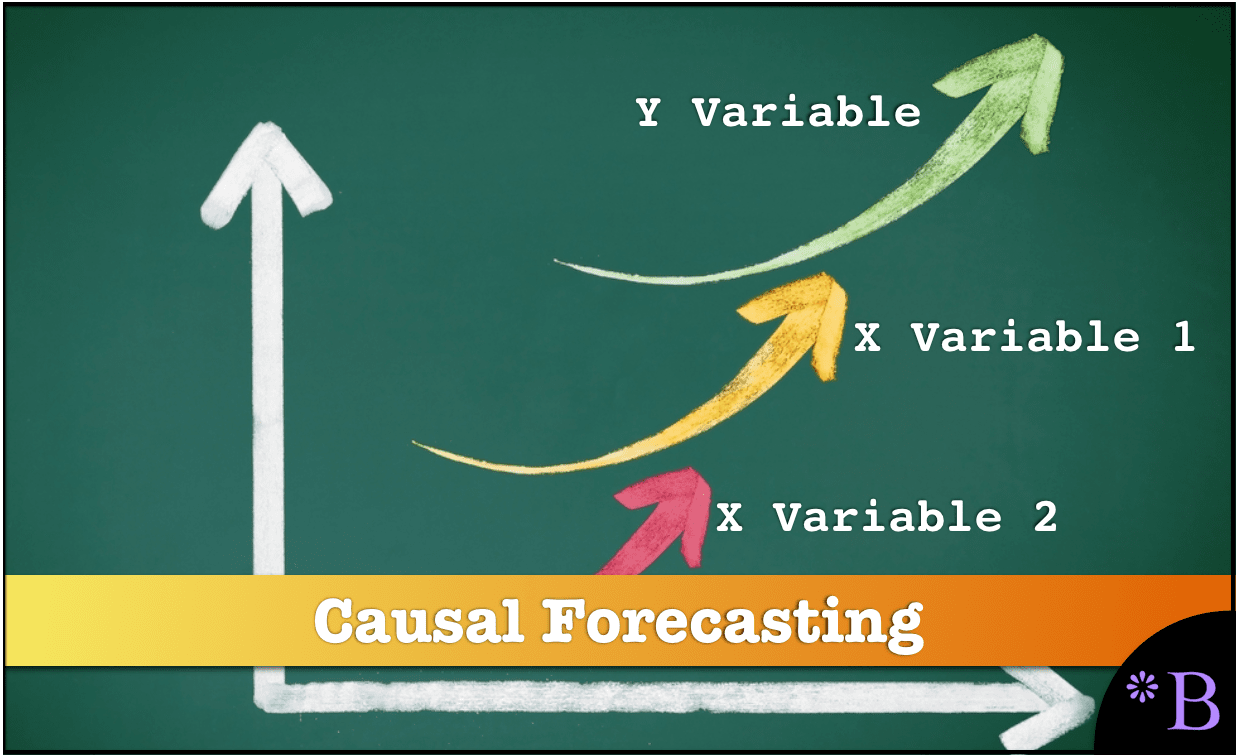The Missed Opportunity of Causal Forecasting?
Executive Summary
- Causal forecasting is a method of forecasting based upon tying the forecast to a variable.
- Causal forecasting is little used in statistical forecasting.

What Is Causal Forecasting?
Causal forecasting is forecasting one value by another value. There are various forms of complexity concerning causal forecasting. However, the most simple mathematical explanation is the following:
Forecasted Variable = Value x Causal + Constant
Here you can see a simple formula that is generated by a best-fit line. The best fit line is a line that is drawn, which best fits the data points.
See our references for this article and related articles at this link.
How Is It Used In Supply Chain Management?
The answer is very sparingly. Causal forecasting is applied in some other fields, most notably finance and weather forecasting. There have been many books or sections of books written about causal forecasting, and it is widely discussed, although more by academics than by practitioners. However, it is still not widely applied.
There are several reasons for this:
- Causal forecasting is higher maintenance than competing for forecasting methods such as time series.
- Companies do not apply very many resources to the statistical forecasting process
- Companies do not hire individuals with sufficient technical and mathematical knowledge to work on the mathematical side of forecasting
The maintenance aspect of causal forecasting is a real problem for supply chain demand planning departments, which typically have little in the way of resources to very much complex forecasting. Secondly, the way that forecasting systems often implement causal forecasting is so high maintenance that there is a disincentive to use it.
SAP DP has created such a high maintenance approach to causal forecasting that almost no companies use their functionality. This is the causal forecast configuration screen. SAP’s design misunderstands how few resources supply chain demand planning departments have to perform forecasting. The fact that companies continue to buy poor forecasting applications is indicative of how little most executive decision-makers know about forecasting software, and how little testing is performed on software before selection.
Low Maintenance Causal Forecasting
I have developed a way to use causal forecasting, which is far lower maintenance based upon the use of attributes. In this approach, the causal formula is calculated externally in say Excel. Then once the relationship is determined between the predictive variable and the forecast, and the predictive variable’s forecast is generated, a percentage increase or decrease can be applied per attribute product grouping. To understand how this works, it’s important to understand attribute-based forecasting, which I provide coverage in this article.
This approach is probably one of the few ways that causal forecasting could find its way into companies. However, almost no one is aware of this approach, and the vast majority of companies in the supply chain lack the software to implement the approach. So it for all intents and purposes does not exist.
The Result
The result of these three factors is that even for large companies, consistently applying much more than simple time series techniques to their supply chain forecasting process is beyond their capability. This brings up an interesting point.
The financial sector’s budget for forecasting software and talent is quite a bit different from that of supply chain forecasting. This is part of the misallocation of resources from the sector of the economy that observes and places bets on which entities will increase in value, to the part of the economy that adds value.
Forecasting in the Fake Economy
The most consistent and advanced users of causal forecasting techniques are in the financial industry, i.e., Wall Street, hedge funds, etc… In finance, causal forecasting is also referred to as leading indicator forecasting. Forecasting in finance is far more sophisticated, although far less glandular. While a company with a supply chain can have 100,000s of thousands of SKU-Locations to forecast, generally, a firm in finance trying to predict the movements of a financial instrument (stock, bond, currency, etc..) is attempting to forecast only a few variables at a time.
While a company with a supply chain may not do causal forecasting at all, of if they do forecast with one causal, a financial firm may use ten or more independent variables (Xs) to perform the forecast. This is an interesting statement about how resources are allocated in an economy. Far greater resources are being spent in financial forecasting than in the supply chain. That is far more effort is going into forecasting the fake Wall Street economy over the real economy for products and things.
Conclusion
Causal forecasting is a vital forecasting method that is underutilized by companies that both lack the resources and attention and follow through to implement causal systems. The most basic causal system to implement is an overall macroeconomic variable (such as predicted GDP growth or decline) to the entire product database. This type of forecast adjustment can be applied before any other forecasting is performed to tie future sales to the overall economy effectively. As different products react differently to changes in the economy, the regression formula would have to be determined to know how much or how little to change the top-level forecast in response to economic vacillations. <p “>Secondly, other macroeconomic indicators that are most industry-specific can be used relatively easily. For instance, a lumber company could use future housing starts to forecast the demand for its product. However, the current way of applying causal forecasting to SKUs is too high maintenance. I will cover a better way in the book “Supply Chain Forecasting Software.”

